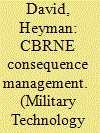|
|
|
Sort Order |
|
|
|
Items / Page
|
|
|
|
|
|
|
| Srl | Item |
| 1 |
ID:
076351


|
|
|
|
|
| Publication |
2006.
|
| Summary/Abstract |
In a climate of political concern about the deliberate dissemination of pathogenic micro-organisms, this article assesses the nature and scope of the threat to national security posed by actors other than states. Key factors include the motivations and disincentives for carrying out a biological attack and the technical challenges likely to be encountered by a non-state organization that decides to use disease as its weapon of choice. The assessment concludes that non-state organizations do not at present pose a great threat, that biological attacks should generally not be regarded as a 'WMD' issue, but also that the conduct of individual scientists engaged in pathogen research warrants careful monitoring.
|
|
|
|
|
|
|
|
|
|
|
|
|
|
|
|
| 2 |
ID:
093389


|
|
|
| 3 |
ID:
107478


|
|
|
|
|
| Publication |
2011.
|
| Summary/Abstract |
A biological attack would present an unprecedented challenge for local, state, and federal agencies, the military, the private sector, and individuals on many fronts, ranging from vaccination and treatment to prioritization of cleanup actions to waste disposal. To prepare for recovery from this type of incident, the Seattle Urban Area Security Initiative (UASI) partners collaborated with military and federal agencies to develop a regional recovery framework. The goal was to identify key information that will assist policymakers and emergency managers in shortening the timeline for recovery and minimizing the economic and public health impacts of a catastrophic anthrax attack. Based on discussions in workshops, tabletop exercises, and interviews with local, state, federal, military, and private sector entities responsible for recovery, the authors identified goals, assumptions, and concepts of operation for various areas to address critical issues the region will face as recovery progresses. Although the framework is specific to a catastrophic, wide-area biological attack using anthrax, it was designed to be flexible and scalable so it could also serve as the recovery framework for an all-hazards approach in other regions and jurisdictions. Benefits from this process include enhanced coordination and collaboration across agencies, a more thorough understanding of the anthrax threat, an opportunity to proactively consider long-term recovery, and a better understanding of the specific policy questions requiring resolution.
|
|
|
|
|
|
|
|
|
|
|
|
|
|
|
|
|
|
|
|
|